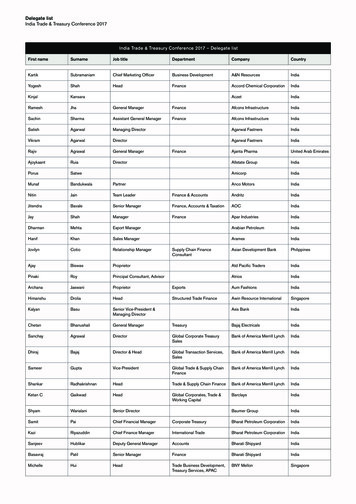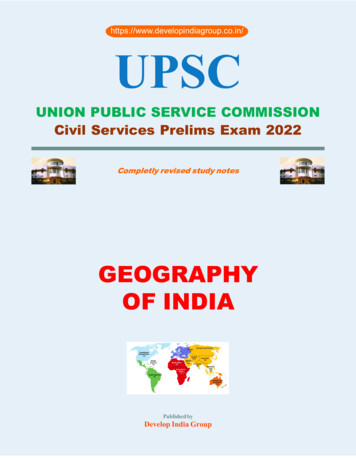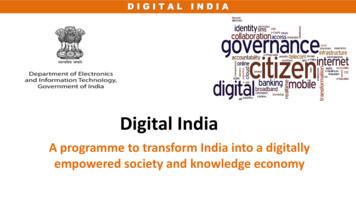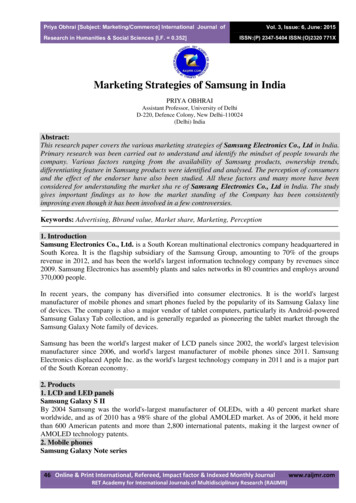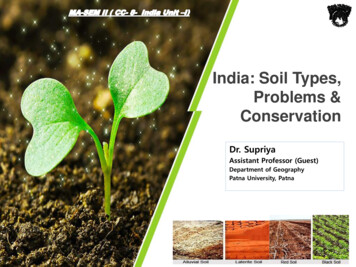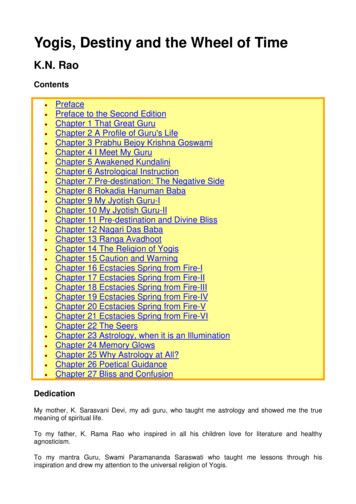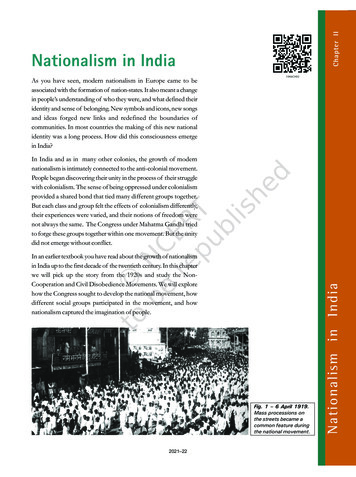
Transcription
Chapter IINationalism in IndiaAs you have seen, modern nationalism in Europe came to beassociated with the formation of nation-states. It also meant a changein people’s understanding of who they were, and what defined theiridentity and sense of belonging. New symbols and icons, new songsand ideas forged new links and redefined the boundaries ofcommunities. In most countries the making of this new nationalidentity was a long process. How did this consciousness emergein India?In India and as in many other colonies, the growth of modernnationalism is intimately connected to the anti-colonial movement.People began discovering their unity in the process of their strugglewith colonialism. The sense of being oppressed under colonialismprovided a shared bond that tied many different groups together.But each class and group felt the effects of colonialism differently,their experiences were varied, and their notions of freedom werenot always the same. The Congress under Mahatma Gandhi triedto forge these groups together within one movement. But the unitydid not emerge without conflict.Nationalismin IndiaNationalism in IndiaIn an earlier textbook you have read about the growth of nationalismin India up to the first decade of the twentieth century. In this chapterwe will pick up the story from the 1920s and study the NonCooperation and Civil Disobedience Movements. We will explorehow the Congress sought to develop the national movement, howdifferent social groups participated in the movement, and hownationalism captured the imagination of people.Fig. 1 – 6 April 1919.Mass processions onthe streets became acommon feature duringthe national movement.2021–2229
1 The First World War, Khilafat and Non-CooperationIn the years after 1919, we see the national movement spreading tonew areas, incorporating new social groups, and developing newmodes of struggle. How do we understand these developments?What implications did they have?First of all, the war created a new economic and political situation.It led to a huge increase in defence expenditure which was financedby war loans and increasing taxes: customs duties were raised andincome tax introduced. Through the war years prices increased –doubling between 1913 and 1918 – leading to extreme hardshipfor the common people. Villages were called upon to supply soldiers,and the forced recruitment in rural areas caused widespread anger.Then in 1918-19 and 1920-21, crops failed in many parts of India,resulting in acute shortages of food. This was accompanied by aninfluenza epidemic. According to the census of 1921, 12 to 13 millionpeople perished as a result of famines and the epidemic.New wordsForced recruitment – A process by which thecolonial state forced people to join the armyPeople hoped that their hardships would end after the war wasover. But that did not happen.At this stage a new leader appeared and suggested a new modeof struggle.1.1 The Idea of SatyagrahaIndia and the Contemporary WorldMahatma Gandhi returned to India in January 1915. As you know,he had come from South Africa where he had successfully foughtFig. 2 – Indian workers in SouthAfrica march through Volksrust, 6November 1913.Mahatma Gandhi was leading theworkers from Newcastle toTransvaal. When the marchers werestopped and Gandhiji arrested,thousands of more workers joinedthe satyagraha against racist lawsthat denied rights to non-whites.302021–22
After arriving in India, Mahatma Gandhi successfully organisedsatyagraha movements in various places. In 1917 he travelled toChamparan in Bihar to inspire the peasants to struggle against theoppressive plantation system. Then in 1917, he organised a satyagrahato support the peasants of the Kheda district of Gujarat. Affectedby crop failure and a plague epidemic, the peasants of Kheda couldnot pay the revenue, and were demanding that revenue collection berelaxed. In 1918, Mahatma Gandhi went to Ahmedabad to organisea satyagraha movement amongst cotton mill workers.1.2 The Rowlatt ActEmboldened with this success, Gandhiji in 1919 decided to launch anationwide satyagraha against the proposed Rowlatt Act (1919). ThisAct had been hurriedly passed through the Imperial LegislativeCouncil despite the united opposition of the Indian members. Itgave the government enormous powers to repress political activities,and allowed detention of political prisoners without trial for twoyears. Mahatma Gandhi wanted non-violent civil disobedience againstsuch unjust laws, which would start with a hartal on 6 April.Source AMahatma Gandhi on Satyagraha‘It is said of “passive resistance” that it is theweapon of the weak, but the power which isthe subject of this article can be used onlyby the strong. This power is not passiveresistance; indeed it calls for intense activity. Themovement in South Africa was not passivebut active ‘ Satyagraha is not physical force. A satyagrahidoes not inflict pain on the adversary; he doesnot seek his destruction In the use ofsatyagraha, there is no ill-will whatever.‘ Satyagraha is pure soul-force. Truth is the verysubstance of the soul. That is why this force iscalled satyagraha. The soul is informed withknowledge. In it burns the flame of love. Nonviolence is the supreme dharma ‘It is certain that India cannot rival Britain orEurope in force of arms. The British worship thewar-god and they can all of them become, asthey are becoming, bearers of arms. Thehundreds of millions in India can never carry arms.They have made the religion of non-violence theirown .’SourceActivityRead the text carefully. What did MahatmaGandhi mean when he said satyagraha isactive resistance?Nationalism in Indiathe racist regime with a novel method of mass agitation, which hecalled satyagraha. The idea of satyagraha emphasised the power oftruth and the need to search for truth. It suggested that if the causewas true, if the struggle was against injustice, then physical force wasnot necessary to fight the oppressor. Without seeking vengeance orbeing aggressive, a satyagrahi could win the battle through nonviolence. This could be done by appealing to the conscience of theoppressor. People – including the oppressors – had to be persuadedto see the truth, instead of being forced to accept truth through theuse of violence. By this struggle, truth was bound to ultimatelytriumph. Mahatma Gandhi believed that this dharma of non-violencecould unite all Indians.Rallies were organised in various cities, workers went on strike inrailway workshops, and shops closed down. Alarmed by the popularupsurge, and scared that lines of communication such as the railwaysand telegraph would be disrupted, the British administration decidedto clamp down on nationalists. Local leaders were picked up fromAmritsar, and Mahatma Gandhi was barred from entering Delhi.On 10 April, the police in Amritsar fired upon a peaceful procession,provoking widespread attacks on banks, post offices and railwaystations. Martial law was imposed and General Dyer took command.2021–2231
On 13 April the infamous Jallianwalla Bagh incident took place. Onthat day a large crowd gathered in the enclosed ground of JallianwallaBagh. Some came to protest against the government’s new repressivemeasures. Others had come to attend the annual Baisakhi fair. Beingfrom outside the city, many villagers were unaware of the martiallaw that had been imposed. Dyer entered the area, blocked the exitpoints, and opened fire on the crowd, killing hundreds. His object,as he declared later, was to ‘produce a moral effect’, to create in theminds of satyagrahis a feeling of terror and awe.India and the Contemporary WorldAs the news of Jallianwalla Bagh spread, crowds took to the streetsin many north Indian towns. There were strikes, clashes with thepolice and attacks on government buildings. The governmentresponded with brutal repression, seeking to humiliate and terrorisepeople: satyagrahis were forced to rub their noses on the ground,crawl on the streets, and do salaam (salute) to all sahibs; people wereflogged and villages (around Gujranwala in Punjab, now in Pakistan)were bombed. Seeing violence spread, Mahatma Gandhi called offthe movement.While the Rowlatt satyagraha had been a widespread movement, itwas still limited mostly to cities and towns. Mahatma Gandhi now feltthe need to launch a more broad-based movement in India. But hewas certain that no such movement could be organised withoutbringing the Hindus and Muslims closer together. One way of doingthis, he felt, was to take up the Khilafat issue. The First World War hadended with the defeat of Ottoman Turkey. And there were rumoursthat a harsh peace treaty was going to be imposed on the Ottomanemperor – the spiritual head of the Islamic world (the Khalifa). Todefend the Khalifa’s temporal powers, a Khilafat Committee wasformed in Bombay in March 1919. A young generation of Muslimleaders like the brothers Muhammad Ali and Shaukat Ali, begandiscussing with Mahatma Gandhi about the possibility of a unitedmass action on the issue. Gandhiji saw this as an opportunity to bringMuslims under the umbrella of a unified national movement. At theCalcutta session of the Congress in September 1920, he convincedother leaders of the need to start a non-cooperation movement insupport of Khilafat as well as for swaraj.1.3 Why Non-cooperation?In his famous book Hind Swaraj (1909) Mahatma Gandhi declaredthat British rule was established in India with the cooperation of322021–22Fig. 3 – General Dyer’s ‘crawling orders’ beingadministered by British soldiers, Amritsar,Punjab, 1919.
Indians, and had survived only because of this cooperation. If Indiansrefused to cooperate, British rule in India would collapse within ayear, and swaraj would come.How could non-cooperation become a movement? Gandhijiproposed that the movement should unfold in stages. It should beginwith the surrender of titles that the government awarded, and aboycott of civil services, army, police, courts and legislative councils,schools, and foreign goods. Then, in case the government usedrepression, a full civil disobedience campaign would be launched.Through the summer of 1920 Mahatma Gandhi and Shaukat Alitoured extensively, mobilising popular support for the movement.New wordsBoycott – The refusal to deal and associate withpeople, or participate in activities, or buy anduse things; usually a form of protestMany within the Congress were, however, concerned about theproposals. They were reluctant to boycott the council electionsscheduled for November 1920, and they feared that the movementmight lead to popular violence. In the months between Septemberand December there was an intense tussle within the Congress. For awhile there seemed no meeting point between the supporters andthe opponents of the movement. Finally, at the Congress session atNagpur in December 1920, a compromise was worked out andthe Non-Cooperation programme was adopted.Nationalism in IndiaHow did the movement unfold? Who participated in it? How diddifferent social groups conceive of the idea of Non-Cooperation?Fig. 4 – The boycott of foreigncloth, July 1922.Foreign cloth was seen as thesymbol of Western economicand cultural domination.2021–2233
2 Differing Strands within the MovementThe Non-Cooperation-Khilafat Movement began in January 1921.Various social groups participated in this movement, each with itsown specific aspiration. All of them responded to the call of Swaraj,but the term meant different things to different people.2.1 The Movement in the TownsThe movement started with middle-class participation in the cities.Thousands of students left government-controlled schools andcolleges, headmasters and teachers resigned, and lawyers gave uptheir legal practices. The council elections were boycotted in mostprovinces except Madras, where the Justice Party, the party of thenon-Brahmans, felt that entering the council was one way of gainingsome power – something that usually only Brahmans had access to.India and the Contemporary WorldThe effects of non-cooperation on the economic front were moredramatic. Foreign goods were boycotted, liquor shops picketed,and foreign cloth burnt in huge bonfires. The import of foreigncloth halved between 1921 and 1922, its value dropping fromRs 102 crore to Rs 57 crore. In many places merchants and tradersrefused to trade in foreign goods or finance foreign trade. As theboycott movement spread, and people began discarding importedclothes and wearing only Indian ones, production of Indian textilemills and handlooms went up.But this movement in the cities gradually slowed down for a varietyof reasons. Khadi cloth was often more expensive than massproduced mill cloth and poor people could not afford to buy it.How then could they boycott mill cloth for too long? Similarly theboycott of British institutions posed a problem. For the movementto be successful, alternative Indian institutions had to be set upso that they could be used in place of the British ones. These wereslow to come up. So students and teachers began tricklingback to government schools and lawyers joined back work ingovernment courts.2.2 Rebellion in the CountrysideFrom the cities, the Non-Cooperation Movement spread to thecountryside. It drew into its fold the struggles of peasants and tribals342021–22New wordsPicket – A form of demonstration or protestby which people block the entrance to a shop,factory or officeActivityThe year is 1921. You are a student in agovernment-controlled school. Design aposter urging school students to answerGandhiji’s call to join the Non-CooperationMovement.
which were developing in different parts of India in the yearsafter the war.In Awadh, peasants were led by Baba Ramchandra – a sanyasi whohad earlier been to Fiji as an indentured labourer. The movementhere was against talukdars and landlords who demanded frompeasants exorbitantly high rents and a variety of other cesses. Peasantshad to do begar and work at landlords’ farms without any payment.As tenants they had no security of tenure, being regularly evicted sothat they could acquire no right over the leased land. The peasantmovement demanded reduction of revenue, abolition of begar, andsocial boycott of oppressive landlords. In many places nai – dhobibandhs were organised by panchayats to deprive landlords of theservices of even barbers and washermen. In June 1920, JawaharlalNehru began going around the villages in Awadh, talking to thevillagers, and trying to understand their grievances. By October, theOudh Kisan Sabha was set up headed by Jawaharlal Nehru, BabaRamchandra and a few others. Within a month, over 300 brancheshad been set up in the villages around the region. So when the NonCooperation Movement began the following year, the effort of theCongress was to integrate the Awadh peasant struggle into the widerstruggle. The peasant movement, however, developed in forms thatthe Congress leadership was unhappy with. As the movement spreadin 1921, the houses of talukdars and merchants were attacked,bazaars were looted, and grain hoards were taken over. In manyplaces local leaders told peasants that Gandhiji had declared thatno taxes were to be paid and land was to be redistributed amongthe poor. The name of the Mahatma was being invoked to sanctionall action and aspirations.New wordsBegar – Labour that villagers were forced tocontribute without any paymentActivityIf you were a peasant in Uttar Pradesh in 1920,how would you have responded to Gandhiji’scall for Swaraj? Give reasons for your response.In 1928, Vallabhbhai Patel led the peasantmovement in Bardoli, a taluka in Gujarat, againstenhancement of land revenue. Known as theBardoli Satyagraha, this movement was a successunder the able leadership of Vallabhbhai Patel.The struggle was widely publicised andgenerated immense sympathy in many partsof India.Nationalism in IndiaSource BOn 6 January 1921, the police in United Provinces fired at peasants near Rae Bareli. Jawaharlal Nehru wanted to go tothe place of firing, but was stopped by the police. Agitated and angry, Nehru addressed the peasants who gatheredaround him. This is how he later described the meeting:‘They behaved as brave men, calm and unruffled in the face of danger. I do not know how they felt but I know whatmy feelings were. For a moment my blood was up, non-violence was almost forgotten – but for a moment only. Thethought of the great leader, who by God’s goodness has been sent to lead us to victory, came to me, and I saw thekisans seated and standing near me, less excited, more peaceful than I was – and the moment of weakness passed, Ispoke to them in all humility on non-violence – I needed the lesson more than they – and they heeded me andpeacefully dispersed.’Quoted in Sarvapalli Gopal, Jawaharlal Nehru: A Biography, Vol. I.2021–22Source35
Tribal peasants interpreted the message of Mahatma Gandhi andthe idea of swaraj in yet another way. In the Gudem Hills of AndhraPradesh, for instance, a militant guerrilla movement spread inthe early 1920s – not a form of struggle that the Congress couldapprove. Here, as in other forest regions, the colonial governmenthad closed large forest areas, preventing people from enteringthe forests to graze their cattle, or to collect fuelwood and fruits.This enraged the hill people. Not only were their livelihoodsaffected but they felt that their traditional rights were being denied.When the government began forcing them to contribute begarfor road building, the hill people revolted. The person who cameto lead them was an interesting figure. Alluri Sitaram Raju claimedthat he had a variety of special powers: he could make correctastrological predictions and heal people, and he could surviveeven bullet shots. Captivated by Raju, the rebels proclaimed thathe was an incarnation of God. Raju talked of the greatness ofMahatma Gandhi, said he was inspired by the Non-CooperationMovement, and persuaded people to wear khadi and give up drinking.But at the same time he asserted that India could be liberated onlyby the use of force, not non-violence. The Gudem rebels attackedpolice stations, attempted to kill British officials and carried onguerrilla warfare for achieving swaraj. Raju was captured andexecuted in 1924, and over time became a folk hero.India and the Contemporary World2.3 Swaraj in the PlantationsWorkers too had their own understanding of Mahatma Gandhiand the notion of swaraj. For plantation workers in Assam, freedommeant the right to move freely in and out of the confined space inwhich they were enclosed, and it meant retaining a link with thevillage from which they had come. Under the Inland EmigrationAct of 1859, plantation workers were not permitted to leave thetea gardens without permission, and in fact they were rarely givensuch permission. When they heard of the Non-CooperationMovement, thousands of workers defied the authorities, left theplantations and headed home. They believed that Gandhi Raj wascoming and everyone would be given land in their own villages.They, however, never reached their destination. Stranded on the wayby a railway and steamer strike, they were caught by the police andbrutally beaten up.362021–22ActivityFind out about other participants in theNational Movement who were captured andput to death by the British. Can you think of asimilar example from the national movementin Indo-China (Chapter 2)?
The visions of these movements were not defined by the Congressprogramme. They interpreted the term swaraj in their own ways,imagining it to be a time when all suffering and all troubles wouldbe over. Yet, when the tribals chanted Gandhiji’s name and raisedslogans demanding ‘Swatantra Bharat’, they were also emotionallyrelating to an all-India agitation. When they acted in the name ofMahatma Gandhi, or linked their movement to that of the Congress,they were identifying with a movement which went beyond the limitsof their immediate locality.2021–22Nationalism in IndiaFig. 5 – Chauri Chaura, 1922.At Chauri Chaura in Gorakhpur, a peaceful demonstration in a bazaar turned into aviolent clash with the police. Hearing of the incident, Mahatma Gandhi called a haltto the Non-Cooperation Movement.37
3 Towards Civil DisobedienceIn February 1922, Mahatma Gandhi decided to withdraw theNon-Cooperation Movement. He felt the movement was turningviolent in many places and satyagrahis needed to be properly trainedbefore they would be ready for mass struggles. Within the Congress,some leaders were by now tired of mass struggles and wanted toparticipate in elections to the provincial councils that had been setup by the Government of India Act of 1919. They felt that it wasimportant to oppose British policies within the councils, argue forreform and also demonstrate that these councils were not trulydemocratic. C. R. Das and Motilal Nehru formed the Swaraj Partywithin the Congress to argue for a return to council politics. Butyounger leaders like Jawaharlal Nehru and Subhas Chandra Bosepressed for more radical mass agitation and for full independence.Lala Lajpat Rai was assaulted by the British policeduring a peaceful demonstration against theSimon Commission. He succumbed to injuriesthat were inflicted on him during thedemonstration.India and the Contemporary WorldIn such a situation of internal debate and dissension two factorsagain shaped Indian politics towards the late 1920s. The first wasthe effect of the worldwide economic depression. Agricultural pricesbegan to fall from 1926 and collapsed after 1930. As the demandfor agricultural goods fell and exports declined, peasants found itdifficult to sell their harvests and pay their revenue. By 1930, thecountryside was in turmoil.Against this background the new Tory government in Britainconstituted a Statutory Commission under Sir John Simon. Set upin response to the nationalist movement, thecommission was to look into the functioning ofthe constitutional system in India and suggestchanges. The problem was that the commissiondid not have a single Indian member. They wereall British.When the Simon Commission arrived in India in1928, it was greeted with the slogan ‘Go backSimon’. All parties, including the Congress and theMuslim League, participated in the demonstrations.In an effort to win them over, the viceroy, LordIrwin, announced in October 1929, a vague offerof ‘dominion status’ for India in an unspecifiedfuture, and a Round Table Conference to discuss afuture constitution. This did not satisfy the Congressleaders. The radicals within the Congress, led by38Fig. 6 – Meeting of Congress leaders at Allahabad, 1931.Apart from Mahatma Gandhi, you can see Sardar VallabhbhaiPatel (extreme left), Jawaharlal Nehru (extreme right) and SubhasChandra Bose (fifth from right).2021–22
Jawaharlal Nehru and Subhas Chandra Bose, became more assertive.The liberals and moderates, who were proposing a constitutionalsystem within the framework of British dominion, gradually losttheir influence. In December 1929, under the presidency of JawaharlalNehru, the Lahore Congress formalised the demand of ‘PurnaSwaraj’ or full independence for India. It was declared that 26 January1930, would be celebrated as the Independence Day when peoplewere to take a pledge to struggle for complete independence. Butthe celebrations attracted very little attention. So Mahatma Gandhihad to find a way to relate this abstract idea of freedom to moreconcrete issues of everyday life.3.1 The Salt March and the Civil Disobedience MovementMahatma Gandhi found in salt a powerful symbol that could unitethe nation. On 31 January 1930, he sent a letter to Viceroy Irwinstating eleven demands. Some of these were of general interest;others were specific demands of different classes, from industrialiststo peasants. The idea was to make the demands wide-ranging, sothat all classes within Indian society could identify with them andeveryone could be brought together in a united campaign. The moststirring of all was the demand to abolish the salt tax. Salt wassomething consumed by the rich and the poor alike, and it was oneof the most essential items of food. The tax on salt and thegovernment monopoly over its production, Mahatma Gandhideclared, revealed the most oppressive face of British rule.Source CThe Independence Day Pledge, 26 January1930‘We believe that it is the inalienable right of theIndian people, as of any other people, to havefreedom and to enjoy the fruits of their toil andhave the necessities of life, so that they mayhave full opportunities of growth. We believealso that if any government deprives a people ofthese rights and oppresses them, the peoplehave a further right to alter it or to abolish it.The British Government in India has not onlydeprived the Indian people of their freedom buthas based itself on the exploitation of the masses,and has ruined India economically, politically,culturally, and spiritually. We believe, therefore,that India must sever the British connection andattain Purna Swaraj or Complete Independence.’SourceNationalism in IndiaMahatma Gandhi’s letter was, in a way, an ultimatum. If thedemands were not fulfilled by 11 March, the letter stated, theCongress would launch a civil disobedience campaign. Irwin wasunwilling to negotiate. So Mahatma Gandhi started his famoussalt march accompanied by 78 of his trusted volunteers. The marchwas over 240 miles, from Gandhiji’s ashram in Sabarmati to theGujarati coastal town of Dandi. The volunteers walked for 24 days,about 10 miles a day. Thousands came to hear Mahatma Gandhiwherever he stopped, and he told them what he meant by swarajand urged them to peacefully defy the British. On 6 April he reachedDandi, and ceremonially violated the law, manufacturing salt byboiling sea water.This marked the beginning of the Civil Disobedience Movement.How was this movement different from the Non-CooperationMovement? People were now asked not only to refuse cooperation2021–2239
Fig. 7 – The Dandi march.During the salt march MahatmaGandhi was accompanied by78 volunteers. On the waythey were joined by thousands.India and the Contemporary Worldwith the British, as they had done in 1921-22, but also to breakcolonial laws. Thousands in different parts of the country brokethe salt law, manufactured salt and demonstrated in front ofgovernment salt factories. As the movement spread, foreign clothwas boycotted, and liquor shops were picketed. Peasants refused topay revenue and chaukidari taxes, village officials resigned, and inmany places forest people violated forest laws – going into ReservedForests to collect wood and graze cattle.Worried by the developments, the colonial government beganarresting the Congress leaders one by one. This led to violent clashesin many palaces. When Abdul Ghaffar Khan, a devout disciple ofMahatma Gandhi, was arrested in April 1930, angry crowdsdemonstrated in the streets of Peshawar, facing armoured cars andpolice firing. Many were killed. A month later, when MahatmaGandhi himself was arrested, industrial workers in Sholapur attackedpolice posts, municipal buildings, lawcourts and railway stations –all structures that symbolised British rule. A frightened governmentresponded with a policy of brutal repression. Peaceful satyagrahiswere attacked, women and children were beaten, and about 100,000people were arrested.In such a situation, Mahatma Gandhi once again decided to call offthe movement and entered into a pact with Irwin on 5 March 1931.By this Gandhi-Irwin Pact, Gandhiji consented to participate in aRound Table Conference (the Congress had boycotted the first402021–22Fig. 8 – Police cracked down on satyagrahis,1930.
Round Table Conference) in London and the government agreed to Box 1release the political prisoners. In December 1931, Gandhiji went to‘To the altar of this revolution we haveLondon for the conference, but the negotiations broke down andbrought our youth as incense’he returned disappointed. Back in India, he discovered that theMany nationalists thought that the strugglegovernment had begun a new cycle of repression. Ghaffar Khanagainst the British could not be won throughnon-violence. In 1928, the Hindustan Socialistand Jawaharlal Nehru were both in jail, the Congress had beenRepublican Army (HSRA) was founded at adeclared illegal, and a series of measures had been imposed to preventmeeting in Ferozeshah Kotla ground in Delhi.meetings, demonstrations and boycotts. With great apprehension,Amongst its leaders were Bhagat Singh, JatinDas and Ajoy Ghosh. In a series of dramaticMahatma Gandhi relaunched the Civil Disobedience Movement.actions in different parts of India, the HSRAFor over a year, the movement continued, but by 1934 it losttargeted some of the symbols of British power.its momentum.In April 1929, Bhagat Singh and BatukeswarLet us now look at the different social groups that participated in theCivil Disobedience Movement. Why did they join the movement?What were their ideals? What did swaraj mean to them?In the countryside, rich peasant communities – like the Patidars ofGujarat and the Jats of Uttar Pradesh – were active in the movement.Being producers of commercial crops, they were very hard hit bythe trade depression and falling prices. As their cash incomedisappeared, they found it impossible to pay the government’s revenuedemand. And the refusal of the government to reduce the revenuedemand led to widespread resentment. These rich peasants becameenthusiastic supporters of the Civil Disobedience Movement,organising their communities, and at times forcing reluctant members,to participate in the boycott programmes. For them the fight forswaraj was a struggle against high revenues. But they were deeplydisappointed when the movement was called off in 1931 withoutthe revenue rates being revised. So when the movement was restartedin 1932, many of them refused to participate.‘Revolution is the inalienable right of mankind.Freedom is the imprescriptible birthright of all.The labourer is the r
In an earlier textbook you have read about the growth of nationalism in India up to the f irst decade of the tw entieth centur y. In this c hapter we will pick up the story from the 1920s and study the Non-Cooperation and Ci vil Disobedience Mo vements . W e will e xplor e how
